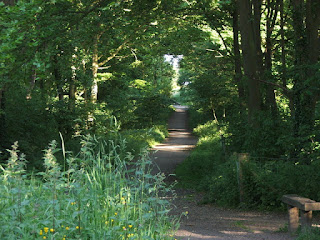Learning about waggonways has been fascinating. At first I thought the word referred only to the pathway the coal carts followed to take coal to a river but the phrase is more inclusive and refers to the path or track, the cart, the horse, and the equipment needed to move coal from the colliery to the river. The first waggonways were paths the horses trod pulling carts full of coal. Eventually two parallel rails were laid on the pathways and cart wheels were made with rims to fit the rails. The waggonways were a precursor to our modern railway system. From what I can tell, waggonways were primarily used in the northeastern counties of England, especially in Northumberland where many of my coal mining ancestors lived.
There seem to have been several benefits to waggonways.
- The path for the carts was smoother and its direction was controlled by the rails.
- The path allowed the horses to continue pulling their carts no matter the weather. No more horses mired in the mud after spring rains.
- Because the paths were smooth, horses could pull heavier loads which meant more coal could be transported at one time. A horse could pull 10.5 tons (21,000 pounds!) for 24 miles. It's hard to imagine that a wooden cart could hold that much weight, let alone that a horse could pull it!
 |
| Waggonway in Summer (from Seaton Delaval to Whitby Bay) cc-by-sa/2.0 - © Christine Westerback geograph.org.uk/p/706555 Used under Creative Commons License. |
Some of the old waggonways have been restored (but without the rails) and used as bicycling or walking paths.
A few years ago the Willington Waggonway, an intact waggonway from the late 18th century that was buried, was discovered at a shipyard in Tyneside, Northumberland. It has been restored and is in the process of preservation. This article at ChronicleLive gives details and shows great photos of the track as well as images of the carts.
I look at the photos of the waggonways paths now and think how charming they look. I have to remind myself of the work--the hard physical labor!--they represent, summer and winter, spring and fall: the miners who dug the coal, the men and boys who were associated in any way with coal mines, as well as the ponies in the mines below ground and the horses who pulled carts along these paths. What a lot of work!
If you'd like to learn more about or see photos of Waggonways, click on these links.
- Wylam Waggonway explores the history of Heddon and the Wylam Colliery Waggonway and includes maps, diagrams, illustrations, and a timeline which extends beyond the colliery's use of the waggonway. (The font is very tiny and light grey = a bit of a challenge for old eyes.)
- Waggonways provides a brief description of waggonways and links to other photos.
- Plessey Wooden Waggonway includes a brief history of the Plessey Waggonway, a drawing of a horse and cart, and diagrams of a cart (called a chaldron) that was still in use in 1965. The brief history gives details I haven't read elsewhere.
- Amusing Planet's post, The Wooden Wagonways of Britain, gives lots of interesting detail about waggonways and some excellent photos of wagons and the restoration work of the Willington Waggonway.
- Northumberland Wagonways gives information about the transition from waggonways to railways.
- The History Blog has a good article about waggonways and the restoration of the Willington Waggonway.
Below are recent views of two other waggonways. My 3x-great-grandfather, William Doyle, a coal miner, died in Plessey after having been run over by a cart wheel. I have no further details and don't know whether or not his death was work-related. Perhaps the cart wheel was on a coal cart below-ground or perhaps a wagon like one in the photos at the top of this post.
 |
| Plessey Old Waggonway cc-by-sa/2.0 - © Tim Fish geograph.org.uk/p/261166 Used under Creative Commons License |
 |
| Wylam Waggonway at Street Houses cc-by-sa/2.0 - © Andrew Curtis geograph.org.uk/p/5100870 Used under Creative Commons License. |
Copyright © 2021 Nancy Messier. All Rights Reserved.
Do not copy or use any content from this blog without written permission from the owner.
.


No comments:
Post a Comment
I appreciate your comments and look forward to reading what you have to say. Thanks for stopping by.